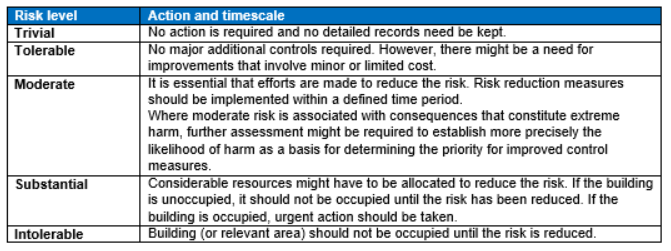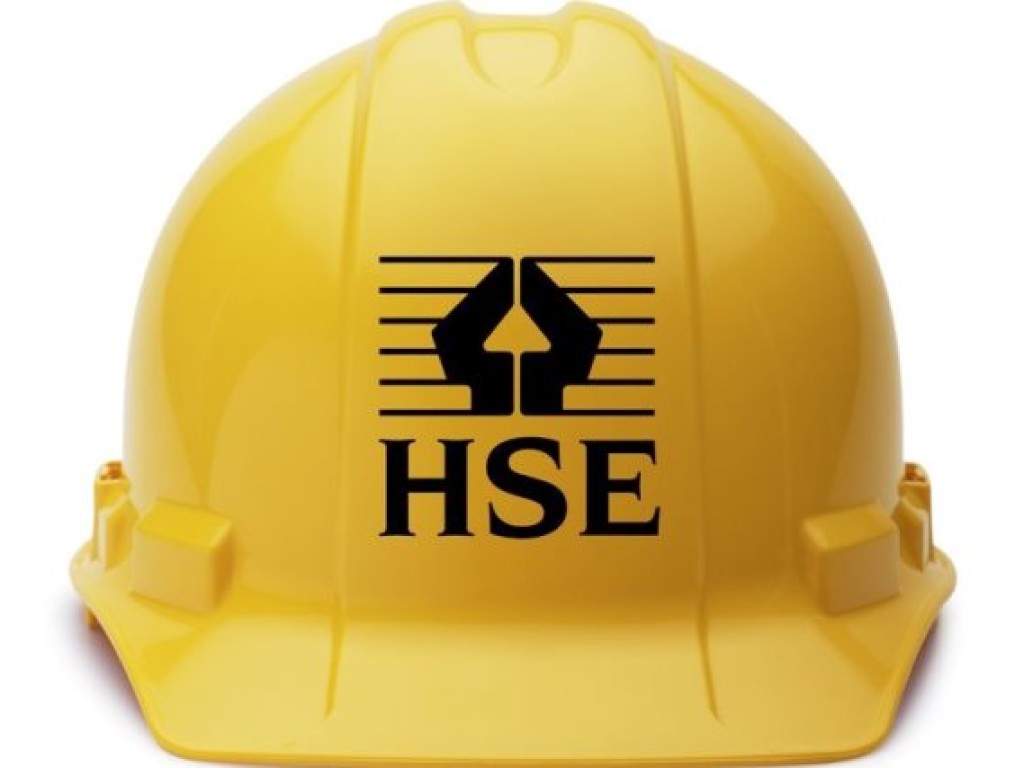Title Page
-
Site conducted
-
Fire Risk assessment Title
-
Responsible Person - Person Having Control of The Premises:
-
Building Number / Name
-
Address of Premises:
-
Person(s) Consulted:
-
Prepared by
-
Additional Assessor/s:
-
Date of Fire Risk Assessment:
-
Date of Previous Fire Risk Assessment:
-
Suggested Date For Review:
General Information
1.1 The Premises
-
1.1 Number of floors
-
1.2 Approximate floor area
-
1.3 Brief details of construction.
-
1.4 Use of premises
2. The Occupants
-
2.1 Approximate maximum number:
-
2.2 Approximate number of employees at any one time:
-
2.3 Maximum number of members of public at any one time:
3. Occupants Especially At Risk From Fire
-
3.1 Disabled occupants:
-
3.2 Occupants in remote areas and lone workers:
-
3.3 Young persons:
-
3.4 Others:
4. Fire Loss Experience
-
Is there any previous history of fire loss in the premises (if yes give details)
5. Other Relevant Information
-
(if yes give details)
6. Relevant Fire Safety Legislation
-
6.1 The following fire safety legislation applies to these premises:
- The Regulatory Reform (Fire Safety Order) 2005
- Other (Give details)
-
6.2 The above legislation is enforced by:
- The Health and Safety Executive (HSE)
- Defence Fire Risk Management Organisation (DFRMO)
- Other (Give Details)
-
6.3 Other legislation that makes significant requirements for fire precautions in these premises (other than the Building Regulations 2000):
- Dangerous Substances & Explosive Atmosphere Regulations
- Control of Substances Hazardous to Health Regulations
- Other (give details)
-
6.4 Comments and deficiencies observed:
Fire Hazards and Their Elimination or Control
7. Electrical Sources Of Ignition
-
7.1 Reasonable measures taken to prevent fires of electrical origin?
-
7.2 More specifically:
-
7.2.1 Fixed installation periodically inspected and tested?
-
7.2.2 Portable appliance testing carried out?
-
7.2.3 Suitable policy regarding the use of personal electrical appliances?
-
7.2.4 Suitable limitation of trailing leads and adapters?
-
7.3 Comments and hazards observed:
8. Smoking
-
8.1 Reasonable measures taken to prevent fires as a result of smoking?
-
8.2 More specifically:
-
8.2.1 Smoking prohibited in the building?
-
8.2.2 Smoking prohibited in appropriate areas?
-
8.2.3 Suitable arrangements for those who wish to smoke
-
8.2.4 This policy appeared to be observed at time of inspection?
-
8.3 Comments and hazards observed:
9. Arson
-
9.1 Does basic security against arson by outsiders appear reasonable?
-
9.2 Is there an absence of unnecessary fire load in close proximity to the premises or available for ignition by outsiders?
-
9.3 Comments and hazards observed:
10. Portable Heaters and Heating Installations
-
10.1 Is the use of portable heaters avoided as far as practicable?
-
10.2 Are portable heaters used?
-
10.2.1 Is the use of the more hazardous type (e.g. radiant bar fires or LPG appliances) avoided?
-
10.2.2 Are suitable measures taken to minimize the hazard of ignition of combustible materials?
-
10.3 Are fixed heating installations subject to regular maintenance?
-
10.4 Comments and hazards observed:
11. Cooking
-
11.1 Are reasonable measures taken to prevent fires as a result of cooking?
-
11.2 More specifically:
-
11.2.1 Filters changed and ductwork cleaned regularly?
-
11.2.2 Suitable extinguishing appliances available?
-
11.3 Comments and hazards observed:
12. Lightning
-
12.1 Does the building have adequate lightning protection system?
-
12.2 Comments and deficiencies observed:
13. Housekeeping
-
13.1 Is the standard of housekeeping adequate?
-
13.2 More specifically:
-
13.2.1 Combustible materials appear to be separated from ignition sources?
-
13.2.2 Avoidance of unnecessary accumulation of combustible materials or waste?
-
13.2.3 Appropriate storage of hazardous materials?
-
13.2.4 Avoidance of inappropriate storage of combustible materials?
-
13.3 Comments and hazards observed:
14. Hazards Introduced By Outside Contractors and Building Works
-
14.1 Are fire safety conditions imposed on outside contractors?
-
14.2 Is there satisfactory control over works carried out in the building by outside contractors (including “hot work” permits)?
-
14.3 If there are in-house maintenance personnel, are suitable precautions taken during “hot work”, including use of hot work permits?
-
14.4 Comments and hazards observed:
15. Dangerous Substances
-
15.1 If dangerous substances are, or could be, used, has a risk assessment been carried out, as required by the Dangerous Substances and Explosive Atmospheres Regulations 2002?
-
15.2 Comments and hazards observed:
OTHER SIGNIFICANT FIRE HAZARDS THAT WARRANT CONSIDERATION INCLUDING PROCESS HAZARDS THAT IMPACT ON GENERAL FIRE PRECAUTIONS
-
Hazard
-
Comments
Fire Protection Measures
17. Means of Escape From Fire
-
17.1 It is considered that the building is provided with reasonable means of escape in case of fire?
-
17.2 More specifically
-
17.2.1 Adequate design of escape routes?
-
17.2.2 Adequate provision of exits?
-
17.2.3 Exits easily and immediately openable where necessary?
-
17.2.4 Fire exits open in direction of escape where necessary?
-
17.2.5 Avoidance of sliding or revolving doors as fire exits where necessary?
-
17.2.6 Satisfactory means for securing exits?
-
17.3 Reasonable distances of travel
-
17.3.1 Where there is a single direction of travel?
-
17.3.2 Where there are alternative means of escape?
-
17.3.3 Suitable protection of escape routes?
-
17.3.4 Suitable fire precautions for all inner rooms?
-
17.3.5 Escape routes unobstructed?
-
17.4 It is considered that the building is provided with reasonable arrangement for means of escape for disabled people?
-
17.5 Comments and deficiencies observed:
18. Measures to Limit Fire Spread and Development
-
18.1 Is it considered that there is :
-
18.1.1 Compartmentation of a reasonable standard.
-
18.1.2 Reasonable limitation of linings that might promote fire spread
-
18.2 As far as can reasonably be ascertained, fire dampers are provided as necessary to protect critical means of escape against passage of fire, smoke and combustion products in the early stages of a fire? <br>
-
18.3 Comments and deficiencies observed:
19. Emergency Escape Lighting
-
19.1 Reasonable standard of emergency escape lighting system provided?
-
19.2 Comments and deficiencies observed:
20. Fire Safety Signs and Notices
-
20.1 Reasonable standard of fire safety signs and notices?
-
20.2 Comments and deficiencies observed:
21. Means of Giving Warning In Case Of Fire
-
21.1 Reasonable manually operated electrical fire alarm?
-
21.2 Automatic fire detection provided?
-
21.3 Extent of automatic fire detection generally appropriate for the occupancy and fire risk?
-
21.4 Remote transmission of alarm signals?
-
21.5 Comments and deficiencies observed:
22. Manual Fire Extinguishing Appliances
-
22.1 Reasonable provision of portable fire extinguishers?
-
22.2 Hose reels provided?
-
22.3 Are all fire extinguishing appliances readily accessible?
-
22.4 Comments and deficiencies observed:
23. Relevant Automatic Fire Extinguishing Systems
-
23.1 Type of system:
-
23.2 Comments and deficiencies observed:
24. Other Relevant Fixed Systems and Equipment
-
24.1 Type of fixed system:
-
24.2 Comments and deficiencies observed:
-
24.3 Suitable provision of fire-fighters switch(es) for high N/A voltage luminous tube signs, etc.
-
24.4 Comments and deficiencies observed:
Management of Fire Safety
25. Procedures and Arrangements
-
25.1 Fire safety is managed by:
-
25.2 Competent person(s) appointed to assist in undertaking the preventive and protective measures (i.e. relevant general fire precautions)?<br>
-
25.3 Is there a suitable record of the fire safety arrangements?
-
25.4 Appropriate fire procedures in place?
-
25.5 More specifically:
-
25.5.1 Are procedures in the event of fire appropriate and properly documented?
-
25.5.2 Are there suitable arrangements for summoning the fire and rescue service?
-
25.5.3 Are there suitable arrangements to meet the fire and rescue service on arrival and provide relevant information, including that relating to hazards to fire-fighters?
-
25.5.4 Are there suitable arrangements for ensuring that the premises have been evacuated?
-
25.5.5 Is there a suitable fire assembly point(s)?
-
25.5.6 Are there adequate procedures for evacuation of any disabled people who are likely to be present?
-
25.6 Persons nominated and trained to use fire extinguishing appliances?
-
25.7 Persons nominated and trained to assist with evacuation, including evacuation of disabled people?
-
25.8 Appropriate liaison with fire and rescue service (e.g. by fire and rescue service crews visiting for familiarisation visits)?
-
25.9 Routine in-house inspections of fire precautions (e.g. in the course of health and safety inspections)?
-
25.10 Comments and deficiencies observed:
26. Training and Drills
-
26.1 Are all staff given adequate fire safety instruction and training on induction?
-
26.2 Are all staff given adequate periodic refresher training at suitable intervals?
-
26.3 Does fire training provide information, instruction or training on the following:
-
26.3.1 Fire risks in the premises?
-
26.3.2 The fire safety measures in the building?
-
26.3.3 Action in the event of fire?
-
26.3.4 Action on hearing the fire alarm signal?
-
26.3.5 Location of fire extinguishers?
-
26.3.6 Means for summoning the fire and rescue service?
-
26.3.7 Identity of persons nominated to assist with evacuation?
-
26.3.8 Identity of persons nominated to use fire extinguishing appliances?
-
26.4 Are staff with special responsibilities (e.g. fire marshals/wardens) given additional training?
-
26.5 Are fire drills carried out at appropriate intervals?
-
26.6 When the employees of another employer work in the Premises:
-
26.6.1 Is their employer given appropriate information of (e.g. on fire risks and fire safety precautions/arrangements)?
-
26.6.2 Is it ensured that the employees are provided with adequate instructions and information?
-
26.7 Comments and deficiencies observed:
27. Testing and Maintenance
-
27.1 Adequate maintenance of premises?
-
27. 2 Periodic test and servicing of fire detection and alarm system?
-
27.3 Periodic testing routines for emergency escape lighting?
-
27.4 Annual maintenance of fire extinguishing appliances?
-
27.5 Periodic inspection of external escape staircases and gangways?
-
27.6 Six-monthly inspection and annual testing of rising mains?
-
27.7 Weekly and monthly testing, six monthly inspection and annual testing of fire-fighting lifts?
-
27.8 Weekly testing and periodic inspection of sprinkler installations?
-
27.9 Routine checks of final exit doors and/or security fastenings?
-
27.10 Annual inspection and test of lightning protection system?
-
27.11 Other relevant inspections or tests:
-
Comments and deficiencies observed:
28. Records
-
28.1 Appropriate records of fire drills?
-
28.2 Appropriate records of fire training?
-
28.3 Appropriate records of fire alarm tests?
-
28.4 Appropriate records of emergency escape lighting tests?
-
28.5 Appropriate records of maintenance and testing of other fire protection systems?
-
28.6 Comments and deficiencies observed:
Fire Risk Assessment
-
In this context, a definition of the above terms is as follows:
Low: Unusually low likelihood of fire as a result of negligible potential sources of ignition.
Medium: Normal fire hazards (e.g. potential ignition sources) for this type of occupancy, with fire hazards generally subject to appropriate controls (other than minor shortcomings).
High: Lack of adequate controls applied to one or more significant fire hazards, such as
to result in significant increase in likelihood of fire.
Taking into account the nature of the building and the occupants, as well as the fire protection and procedural arrangements observed at the time of this fire risk assessment, it is considered that the consequences for life safety in the event of fire would be -
Taking into account the fire prevention measures observed at the time of this risk assessment, it is considered that the hazard from fire (likelihood of fire) at these premises is:
-
In this context, a definition of the above terms is as follows:
Slight harm: Outbreak of fire unlikely to result in serious injury or death of any occupant (other than an occupant sleeping in a room in which a fire occurs).
Moderate harm: Outbreak of fire could foreseeably result in injury (including serious injury) of one or more occupants, but it is unlikely to involve multiple fatalities.
Extreme harm: Significant potential for serious injury or death of one or more occupants. -
Taking into account the nature of the building and the occupants, as well as the fire protection and procedural arrangements observed at the time of this fire risk assessment, it is considered that the consequences for life safety in the event of fire would be:
-
-
Accordingly, it is considered that the risk to life at these premises is:
-
Comments and deficiencies observed:












